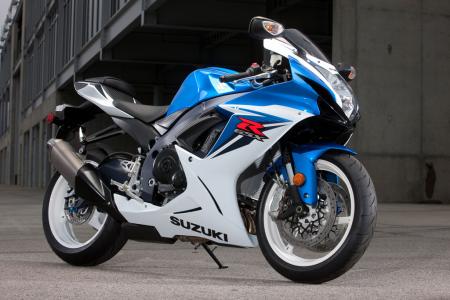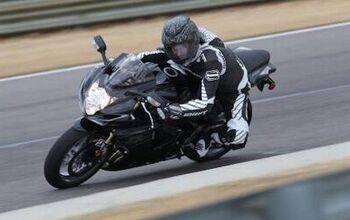2011 Suzuki GSX-R600 Review - Motorcycle.com
During the press launch for the 2011 GSX-R600 – held recently at Barber Motorsports Park in Leeds, Ala. – Suzuki stated that more than 360,000 GSX-R models have been sold in the U.S. since 1986.
“To us at Suzuki, the GSX-R is a brand, it’s not just a model,” said Rod Lopusnak, National Sales Manager at American Suzuki. “That’s how important the GSX-R600, 750, and of course 1000, are to us, to our company. That [GSX-R line] is our DNA. That’s what Suzuki is.”
American Suzuki didn’t have the best year in 2010, but with its new middleweight supersports the company has high hopes of turning matters around in 2011, while at the same time continuing to build on the heritage of GSX-R name.
A Slimmer, Trimmer GSX-R600
Bow to stern, the 600 received a host of changes, many of which targeted reducing weight in order to take advantage of newfound power gains in the low- to mid-range for better acceleration out of corners. Performance-enhancing updates to the inline-Four powerplant focused on reducing mechanical losses by cutting back on weight and reducing friction of engine internals.
Another pivotal power-boosting update is reshaped crankcase ventilation holes, morphing from round on previous models, to pentagonal in shape on the new engine.
Suzuki says the larger, reshaped holes are more efficient at helping reduce crankcase pressure, therefore creating a freer breathing engine. New ratios in the six-speed gearbox (taller first gear, with tighter ratios in gears 2, 3, 4 and 6) were revised to capitalize on what Suzuki says is increased low and mid-range torque.
Make sure to read about these and other updates in our 2011 GSX-R600 and GSX-R750 Revealed article for a comprehensive rundown on the numerous changes to the new Gixxer(s).
Beating the Wet Odds at Barber
Slinging a leg over the Six – now with reshaped tank and slightly wider-set clip-ons – in the pit row garage at Barber, I was reminded how I’ve liked the ergo layout of previous model GSX-R600s, and how I also like the undulating, fluid layout of Barber’s 15-turn, 2.3-mile circuit.
There’s still lots to like with new the 600’s rider layout that offers room to maneuver in the saddle while remaining comfortable during long, self-governed (non-timed) sessions on the track. However, not so likeable was the day’s forecast: thunderstorms and heavy rain.
During a.m. sessions the ominous-looking sky withheld its rainy wrath. The day’s stiff prevailing winds worked in our favor, quickly drying the track left damp by early morning sprinkles. After a handful of warm-up laps, my confidence grew in the grippy, dual-compound Bridgestone BT-016 tires, allowing me to explore the revamped GSX-R600’s chassis performance.
Willing and able is how I’d sum up the Sixxer’s handling if allotted just two words to describe the experience.
Initial turn in is light feeling, yet at the same time predictable. Steering response is one smooth, linear motion from upright to knee-on-the-deck full lean. From front to rear, the chassis does a good job of telegraphing what’s happening at both ends.
Turns 2, 3, 8 and 14 are good spots to sample the Sixxer’s obedience, as these corners are long and wide, giving a rider ample opportunity to tune into what a motorcycle is and isn’t willing to put up with. Need to make a quick, abrupt line change mid-corner? No problemo. The GSX-R responds by giving only what was asked of it, and not an inch more. The bike remained wonderfully composed at all times while under my command.
Some bends in the course, like Turns 4 and 6, terminate at or near the crest of a hill. It’s easy and common to power wheelie while exiting these turns, as you’re often on the gas and sometimes still leaned over – a combination that often leads to a lightened front-end that’s ready to shake its head.
Here again the Suzuki remains obedient, as the electronically controlled steering damper allows only a couple quick wiggles at the bars before bringing the helm back under your control as you continue to open the throttle for a good drive out of the corner.
And a pretty darn good drive you’ll get thanks to a decent spread of mid-range power that becomes noticeably effective by the 8,000 rpm mark. And the closer-ratio gears seem to work as advertised, too. The engine has sufficient pulling power to smoothly tug 3rd gear when you otherwise might think a gear lower is necessary to squirt out of certain corners while aboard a top-end-power-biased supersport.
Engine speed builds deliberately but linearly until around 12,000 rpm where a discernable and sharp boost of power kicks in. From here, the engine spins eagerly and freely all the way to its 15,200-ish redline.
S-DMS (Suzuki-Drive Mode Selector) is retained as a feature on GSX-R models, but now consists of only an A and B mode rather than A, B and C as before. While A mode remains the setting that allows unfettered access to the engine’s power, B mode on the 2011 model results in softer power response that’s even a bit more muted than was the greatly restricted C mode on the previous model.
Through market research Suzuki says it learned that most customers with previous generation S-DMS only noticed some power reduction while in B, and rarely used setting C.
Taking this customer feedback, the company reworked the new S-DMS to reflect a greater and, theoretically, more effective difference in power between the two modes. Additionally, the ECU no longer converts B mode to A mode’s full power if the throttle is opened rapidly as it did on the previous version of S-DMS.
The bike’s brain now keeps the engine in a detuned state across the rev range when in setting B, regardless of the rate at which the throttle is opened.
It’s easy to get sucked into attempting to ride as quick as you dare when on a racetrack, and this trip was no exception – especially since the weather was cooperating at this point in our ride time. Eventually, though, I reminded myself to use my index finger to hit the Mode toggle button located on the upper front side of the right switchgear (carried over with minor changes from the GSX-R1000) in order click over to B mode.
Whoa. That’s some seriously clipped power, that B mode. So gutless was the rate at which the 600 built steam in B, that while exiting the track for a brief rest, I murmured to myself, “Why even bother?”
In fairness, for the right person or right conditions, the reduced output in B might make sense – like for the first-time trackday attendee or during some super-slick road conditions. Otherwise, I’d suspect most riders will spend the majority of time in A.
Two of the most notable upgrades for the Gixxer Sixxer are its Showa Big Piston Fork (BPF) and Brembo monobloc calipers. The BPF is a key contributor to the 600’s chassis stability and handling. With limited front-end dive under braking thanks to the BPF design, there’s less chassis pitch, and overall ride comfort is improved.
Although Barber’s surface is mostly even and smooth, some corners have brake ripples at their entrance – likely the result of the forces generated by racecars during braking. The BPF delivered the right amount of feedback to let me know of the bothersome rough patches while it gobbled up said imperfections.
While the GSX-R600’s dual Brembos didn’t provide the hallmark strong initial bite that I prefer and am used to from the Italian brake maker, they are otherwise a high-performance piece of kit that have elevated the GSX-R’s name and game.
Brake feel at the six-point adjustable lever was consistent, with plenty of feedback to let me know precisely how much more pressure I needed to apply. Experimenting with different brake pad materials could resolve my issue with initial bite.
Conclusion
Despite the ominous forecast of wild, rainy weather with the threat of tornadoes mixed in, barely a drop fell as the moto media circulated ‘round Barber. It wasn’t until after most riders had pulled in the pits for the day that the clouds finally emptied themselves of their watery burden. And they did so, violently. The timing of the rain’s appearance was uncanny.
Is Suzuki blessed with good fortune in 2011 with the GSX-R600?
Of the Big Four, Suzuki is the first player in the past couple years to make a move in the supersport battle. Kawasaki was the last to give its 600 a big overhaul, doing so in 2009. It was enough of an improvement that the ZX-6R dethroned the Honda CBR600RR that year for the title of Winner in our 2009 Supersport Shootout.
In that once-annual battle we lauded the Ninja’s meaty mid-range power for its ability to let a rider get a little lazy with gear selection and pull cleanly out of a slower-speed corner. It’s been a long enough period of time that memory won’t allow making an accurate comparison at this point between the 2011 GSX-R600 and current version of the ZX-6R.
However, in this tightly contested class where every little bit matters, we can’t discount the Ninja’s significant peak horsepower dominance from 2009 when its 107.7 hp was between 5 and 10 more horsepower than the competition.
Nevertheless, Suzuki’s claimed crankshaft output of 123 ponies for the new Gixxer Sixxer, if accurate, could equate to roughly 108 rear wheel horsepower as Kevin Duke keenly speculates. The GSX-R’s advantage of 9 fewer pounds compared to the ZX’s 421-pound curb weight is another feather in the Suzuki’s supersport cap.
While the Suzuki’s engine probably is more potent compared to the previous model GSX-R, what’s more significant to me is the bike’s unmistakable handling agility and ease-of-use.
A supersport that’s user-friendly can greatly boost a rider’s confidence, which may in turn partially make up for a deficit, if any, in engine power. A happy, confident rider is usually one willing to go faster.
(NOTE: The 2011 GSX-R750 was introduced at the same time as the GSX-R600, so keep your eyes on Motorcycle.com in the coming days for a report on the 750 – the Gixxer that started it all!)
Related Reading
2011 Suzuki GSX-R600 and 750 Revealed
2009 Supersport Racetrack Shootout
2009 Supersport Shootout – Street
2009 Supersport Face-off! Kawasaki ZX-6R vs. Triumph Daytona 675
All Things Suzuki on Motorcycle.com
All Things Sportbike on Motorcycle.com
More by Pete Brissette





















![Inside Look at the 2011 Suzuki GSX-R600 [video]](https://cdn-fastly.motorcycle.com/media/2023/05/07/11554789/inside-look-at-the-2011-suzuki-gsx-r600-video.jpg?size=350x220)














Comments
Join the conversation